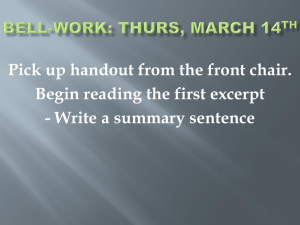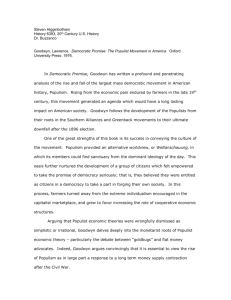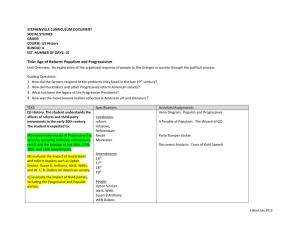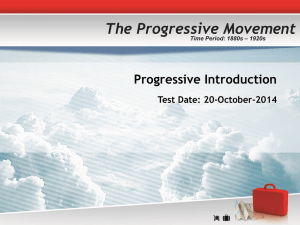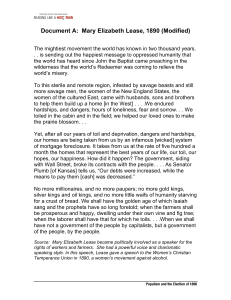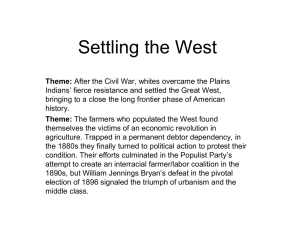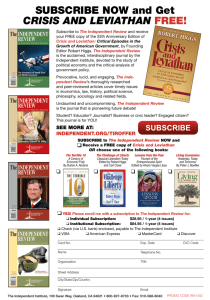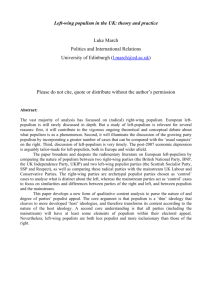Defining US: The American Experience
advertisement
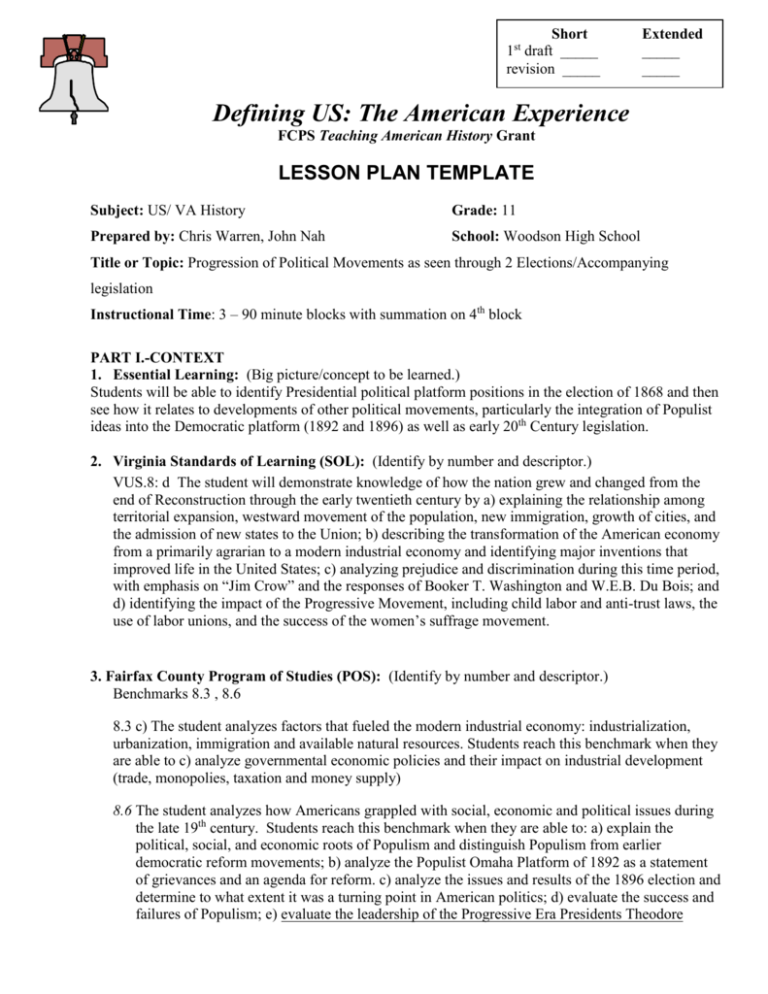
Short 1 draft _____ revision _____ st Extended _____ _____ Defining US: The American Experience FCPS Teaching American History Grant LESSON PLAN TEMPLATE Subject: US/ VA History Grade: 11 Prepared by: Chris Warren, John Nah School: Woodson High School Title or Topic: Progression of Political Movements as seen through 2 Elections/Accompanying legislation Instructional Time: 3 – 90 minute blocks with summation on 4th block PART I.-CONTEXT 1. Essential Learning: (Big picture/concept to be learned.) Students will be able to identify Presidential political platform positions in the election of 1868 and then see how it relates to developments of other political movements, particularly the integration of Populist ideas into the Democratic platform (1892 and 1896) as well as early 20th Century legislation. 2. Virginia Standards of Learning (SOL): (Identify by number and descriptor.) VUS.8: d The student will demonstrate knowledge of how the nation grew and changed from the end of Reconstruction through the early twentieth century by a) explaining the relationship among territorial expansion, westward movement of the population, new immigration, growth of cities, and the admission of new states to the Union; b) describing the transformation of the American economy from a primarily agrarian to a modern industrial economy and identifying major inventions that improved life in the United States; c) analyzing prejudice and discrimination during this time period, with emphasis on “Jim Crow” and the responses of Booker T. Washington and W.E.B. Du Bois; and d) identifying the impact of the Progressive Movement, including child labor and anti-trust laws, the use of labor unions, and the success of the women’s suffrage movement. 3. Fairfax County Program of Studies (POS): (Identify by number and descriptor.) Benchmarks 8.3 , 8.6 8.3 c) The student analyzes factors that fueled the modern industrial economy: industrialization, urbanization, immigration and available natural resources. Students reach this benchmark when they are able to c) analyze governmental economic policies and their impact on industrial development (trade, monopolies, taxation and money supply) 8.6 The student analyzes how Americans grappled with social, economic and political issues during the late 19th century. Students reach this benchmark when they are able to: a) explain the political, social, and economic roots of Populism and distinguish Populism from earlier democratic reform movements; b) analyze the Populist Omaha Platform of 1892 as a statement of grievances and an agenda for reform. c) analyze the issues and results of the 1896 election and determine to what extent it was a turning point in American politics; d) evaluate the success and failures of Populism; e) evaluate the leadership of the Progressive Era Presidents Theodore Roosevelt, William Howard Taft, and Woodrow Wilson in terms of their effectiveness in obtaining passage of reform measures and f)evaluate progressive reforms to expand democracy at local and state levels (referendum, recall, initiative, primaries, direct election of Senators, secret ballot) 4. National History Standard (Historical Thinking Standard) (See handouts from January 12 seminar) I, IV, V The study of culture prepares students to answer questions such as: What are the common characteristics of different cultures? How do belief systems, such as religion or political ideals, influence other parts of the culture? How does the culture change to accommodate different ideas and beliefs? What does language tell us about the culture? In schools, this theme typically appears in units and courses dealing with geography, history, sociology, and anthropology, as well as multicultural topics across the curriculum. Personal identity is shaped by one's culture, by groups, and by institutional influences. Students should consider such questions as: How do people learn? Why do people behave as they do? What influences how people learn, perceive, and grow? How do people meet their basic needs in a variety of contexts? How do individuals develop from youth to adulthood? In schools, this theme typically appears in units and courses dealing with psychology and anthropology. Institutions such as schools, churches, families, government agencies, and the courts play an integral role in people's lives. It is important that students learn how institutions are formed, what controls and influences them, how they influence individuals and culture, and how they are maintained or changed. Students may address questions such as: What is the role of institutions in this and other societies? How am I influenced by institutions? How do institutions change? What is my role in institutional change? In schools this theme typically appears in units and courses dealing with sociology, anthropology, psychology, political science, and history. 5. Learning Strategy(s) Objectives: The main activity in this lesson is to examine the political platforms of the Presidential elections of 1868 and trace the beginning of the Grange movement and the adaptation/integration of some of its key tenets into the Democratic Party platform in 1892 and Populist Party platform in 1896. Additionally, the students would learn about influential key leaders as well as key events that sparked reform and see how this movement contributed to Progressive legislation in the early 20th century. 6. Connection to TAH grant: Content: Information that we have researched independently. Pedagogy: The goal here is to provide students with an opportunity to experience exploratory learning, where knowledge is not just poured into the student but they are exercising skills such as how to make inferences, synthesize new material with previous knowledge, and evaluating materials and ideas based on given criteria. They will make use of available multi-media technology. The Bingo game used as a cumulative summary at the end of day 4 incorporates an activity-based review that is student-centered. CONTINUED PART II. 1. Assessment: There are multiple points at which student understanding will be assessed throughout this lesson. There will be a quiz and the instructor will collect and grade an in-class group writing assignment. Completion of the Bimetallism chart. The Doer’s profile is a student project. Bingo Game is a check for student understanding. Further explanation under instructional strategies. 2. Instructional Strategies: (Describe step by step procedure. Include opener, teacher presentation and student activities.) DAY ONE LESSON 1. Time for student question and answer followed by a quiz on The Americans, Chapter 13,Section 4 (pages 401-405) on previously assigned reading from that chapter and section. 2. Divide class into 10 groups of 3 (assumption is 27-30 students). Each group is then given different generic job occupations to include: 1) farmer, 2) banker, 3) coal miner, 4) new immigrant, 5) small business owner, 6) cowboy, 7) Union/federal soldier, 8) freed slave, and 9) factory worker. Tell them the date is 1865 and the Civil War has just concluded. As a means of review and transition have them give a brief summary of the state of the nation following the Civil War (South is physically and economically devastated, continued Westward expansion, continued Northern boom) When assigning groups make sure that one or two of the highest achieving students are in the group for the FARMER 3. Each group is then given copies of the Democratic Party platform and the Republican Party platform from the election of 1868. They are directed to read the respective platforms from the perspective of their assigned job occupation. The students are then directed to select a recorder. Each group is given 25 minutes to read, analyze and discuss the respective political platforms. On a separate sheet of paper, the group recorder will write down the political platform that BEST represents their interests, if any do at all, and explain why in 1-2 paragraphs. (graded assignment) 4. After each group has turned in their choice to the teacher, the teacher makes a chart on the overhead projector on each group’s occupation and their respective choices of Presidential platform with brief summary of their reasoning. 5. Teacher would summarize with plight of the FARMER, (this should be the focus of the lesson) whose interests are seemingly ignored by both Presidential platforms in 1868. Teacher then shows slide show on the birth of the GRANGE movement, with focus on Oliver Kelley, the Panic of 1873 and the growing resentment between the farmers and the bankers/railroads. 6. For Homework students will create a chart based on their reading that differentiates Goldbugs and Silverites with preparation to discuss in class. DAY TWO LESSON 1. Review and discussion of pre-assigned Homework that differentiates Goldbugs and Silverites. After the HW charts are collected the instructor will show an overhead of an acceptable chart so even students who do not complete homework will acquire instruction while it is reinforcing those that did the assignment. 2. Demonstration of how money is an exercise in faith. The instructor pulls out a dollar bill and asks the question-“What is this?” Students should respond “A dollar” or “money” The instructor will probe further by asking “How do I know that this is a dollar, Why is this universally accepted as a dollar? Is it a dollar in CA or MD?” Students should respond “You can buy things with it” or “Spend it” The instructor will probe further “But why will the store owner accept this as money or something of value? Is there an inherent value to the money itself? If you took this to the US Treasury would they give you a dollar in gold?” The instructor will use this teachable moment to point out that in the South during the Civil War inflation and lack of confidence in the Confederate currency had eroded basic services and transactions in the South. 3. Give students the Economics of bimetallism worksheet and bimetallism chart. Tell them to reform into the groups from the previous day with the assigned role (immigrant, cowboy, farmer, etc) Tell them to answer the questions based on their role. After 20- 25 minutes call them back and review responses while filling in a overhead chart that students can copy. 4. Dramatic reading of the Cross of Gold. Students will play bump where each student reads two sentences and then calls on the next reader. If the reader is lost or not ready, they must read standing up. 5. Slideshow on William Jennings Bryan, his life and times. 6. (Optional) If time permits show a 10-15 minute video clip about the election of 1896 DAY THREE LESSON 1. Doer’s Profile (instructions on sheet) Spend the rest of time in the computer lab having students working on the project with the expectation that they must come ready to present the next day. DAY FOUR LESSON 1. Show Powerpoint slideshow on Reform Movements, amendments, and legislation during the Progressive emphasizing how in many cases they are the fruition of Populist ideals. 2. Have students present their projects. See instructions for grading rubric and limit student presentation to 4 minutes max. Play the Bingo game to check for student understanding repeatedly for prizes (to be determined by instructor) 3. Materials/Resources to be used: - The Americans textbook (previously assigned reading) - Powerpoint slideshow on Grange movement, Oliver Kelley & Panic of 1873 - summary copies of 1868 Democratic and Republican Party platforms - OPTIONAL: 5-10 minute video clip from Schlessinger video series on the Grange movement and time period or the PBS American Experience series 4. Differentiation: In order to facilitate instruction of students from diverse backgrounds, having students work in groups during the political party platform analysis allows students that learn more quickly to help instruct those that do not. 5. Attachments: Job occupations chart Economics of bimetallism worksheet Bimetallism chart Cross of gold Excerpt Doer’s Profile Homework that differentiates Goldbugs and Silverites Homework – Goldbug vs. Silverite chart key Populism vs. Progressivism bingo game Democratic and Republic platforms Democratic and Republican platform outlines 6. Annotated Bibliography: Baack, Ben and Ray, Edward John. "The Political Economy of the Origin and Development of the Federal Income Tax." Research in Economic History 1985 (Supplement 4):121-138. Discusses origins of federal government expansion, the growth of the US military, and the federal income tax system, from the late 19th century to the 1980's. Populist agitation in the late 19th century to reduce import tariffs by instituting an income tax culminated in the passage of the 16th Amendment in 1913. American History and Life, 24A:3273 Bernstein, Irving, ed., "Samuel Gompers and Free Silver, 1896." Mississippi Valley Historical Review. 29(3):394-400. December 1942. Relationship of organized labor to Populism. Gompers saw free silver as threat to trade unionism. Populists make it key issue in 1896, which alienated Gompers. Danzer, Gerald A., J. Jorge Klor de Alva, and Larry S. Krieger. The Americans. Evanston, Illinois: McDougal Littell, 1998. This book is our school’s US History textbook. It is an excellent source due to its thoroughness. It can be somewhat challenging to low-level readers. Chapters relevant to this particular lesson include Chapter 14, 15, and 17 Goebel, Thomas. "The Political Economy of American Populism from Jackson to the New Deal." Studies in American Political Development 1997 11(1): 109-148. Populist republicanism took numerous incarnations. Each shared a common ideology that political favoritism and abuse of political power caused wealth and economic power concentrated wealth into the hands of the few, which eroded American democracy. Included are Jacksonian democracy, the Greenback Party, the Grange reform movement, the Populists, and Progressivism. Each produced a distinctive ideology and language of protest that crossed class and party lines to champion the absolute sovereignty and wisdom of the people. New Deal legislation aimed at dismantling monopolies and trusts made Populism irrelevant. America: History and Life, 35:5077 Hofstadter, Richard. The Age of Reform: From Bryan to F.D.R. New York: Alfred A. Knopf, 1955. Although written fairly close to the time period in which it is studying, Hofstadter astutely recognizes the ways in which the term Populism has become mystified. He seeks to separate actual reform movements from agrarian mythology. Kazin, Michael. The Populist Persuasion: an American History. New York: BasicBooks, 1995. An analysis of the causes and ideological philosophies that guided the development of the Progressive Era in American history. Examines the concerns of individual reformers and activists providing an idea of what individual Populists may have been like. Loomis, Calvin James. "An Interpretation of the Populist and Progressive Parties as a Social Movement." Master's thesis (Political Science), Northern Illinois University, 1953. Zinn, Howard. A People’s History of the United States Teaching Edition. New York: The New Press, 2003, 161-234. A well respected work of short narratives that deliver a lot of content in an interesting way.

